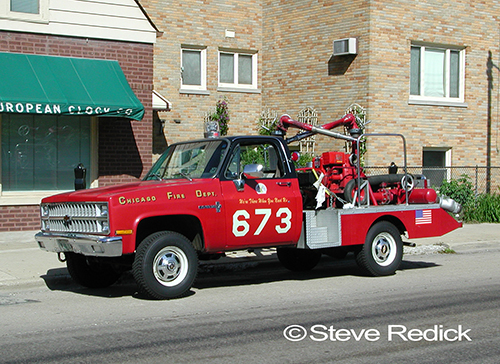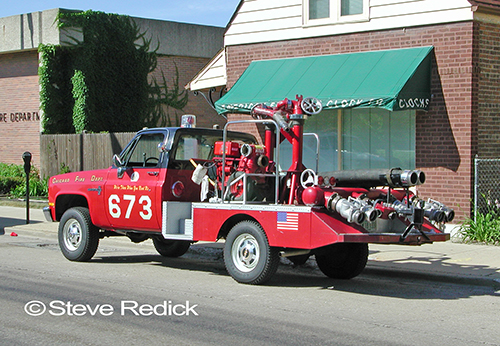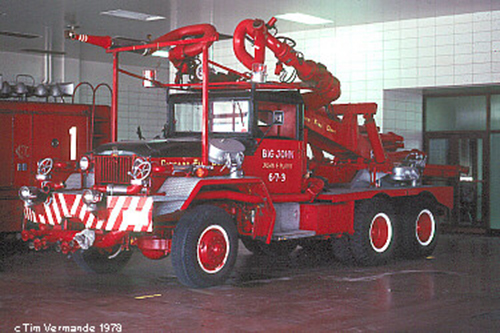More history on the Chicago FD turret wagons – image submissions from Steve Redick … including a great shot of Big John inside Engine 42’s house.

Chicago Fire Department turret wagon 6-7-3. Steve Redick photo

Chicago Fire Department turret wagon 6-7-3. Steve Redick photo
Steve also found this image of Big John

Chicago Fire Department Big John 6-7-3. Tim Vermande photo






























Pingback: Chicago FD Turret Wagon History (pt7) « chicagoareafire.com
#1 by Andy Hogencamp on February 23, 2013 - 4:24 PM
Phil, These units have always fascinated me. A couple of questions: 1. Later pictures of Big John show one of the turrets blocked and then removed. Why? 2. Are these the same guns currently on 671? 3. Big John had a couple of smaller guns on the front bumper did they end up on one of the Chevy units?
Thanks!
#2 by Phil Stenholm on February 17, 2013 - 6:02 PM
Here is some video of “Big Mo” (6-7-2) operating at a couple of fires:
http://www.youtube.com/watch?v=sGnijuc9JZ4
The video is titled “Little John,” “Big John,” and “Big Moe,” but it’a all Big Mo, so the video probably is from 1967-69.
The video shows the turret mounted on the cab-forward Jeep and then after it was transferred to the military-surplus chassis.
None of the video shows Big Mo in the blue & white CD colors it was painted after it was assigned to Engine 42’s house in 1969.
#3 by Bill Post on February 17, 2013 - 5:14 PM
Sebastian, the main reason Engine 5 has been involved in special assignments such as the Water Task Force during the mid 70s to the early 80s, as Phil mentions it’s because of their central location. Besides being off of the Chicago expressway systems major junction point (within two blocks) the famous “spaghetti bowl”, Engine 5’s station was always used as a special operations type of station from the time that they opened their current station at 324 S. Des Plaines in 1928. Engine 5 was the location of a water tower and High Pressure Wagon 1 as well as Light Wagon 1 for many years.
Snorkel 2 was also first put in service in 1959 at Engine 5’s station initially as Water Tower 5, but shortly after renamed Snorkel 2. When Chicago’s Snorkels first were put in service there were only a few stations where they would fit into, so Snorkel 2 was located at Engine 5 from April 1959 until October 1964 when Engine 28’s new station was opened. In May of 1961, Engine 25’s (east building at the fire academy) new house opened and Snorkel 4 was put in service there. For about three and a half years there were two Snorkel companies located less then a mile apart in the “West Loop” because of space limitations in many other fire stations. Engine 5 was one of the larger stations in Chicago as well as being centrally located near the Loop and the West Side. When the expressway system was built in the late 1950s and early 1960s, Engine 5 became an even better location for Special Operations apparatus.
#4 by KB on February 17, 2013 - 12:10 PM
If I were to guess, I would say that Engine 5 has been used as such a specialized unit over the years because of its unique proiximity to a variety of structures within the city. For example, it is very close to the loop and the multitude of high rise buildings. Then, it is also very close to the Dan Ryan, Eisenhower, and Stevenson expressways. Finally, to the south and west, there is many factories and industrial buildings that play a prominent part in that particular area of the city.
#5 by rich on February 17, 2013 - 6:38 AM
does anyone have pics of big john or big mo in action?
#6 by Sebastian on February 17, 2013 - 5:53 AM
Anyone know why cfd’s engine 5 is involved a lot?? Such as it’s a high pressure pumper, also part of haz-mat task force as well as collapse rescue?? It may sound like a dumb question but just curious!!
#7 by Phil Stenholm on February 16, 2013 - 6:03 PM
“Big John” (named for legendary Chicago FD Chief John F. Plant) was in service for only eight years (1970-78). The turret was installed on a 1953 International-Harvester Type 61 U.S. military surplus 6×6 truck chassis acquired by the Chicago Civil Defense Fire & Rescue Service in the 1960s. The turret on “Big John” was the largest of the two mega-turrets operated by the CFD 1967-78.
Along with Hose Wagon 6-1-1 and Engine Companies 5 & 42 (both operating with 2000 GPM pumpers), “Big John”: was part of the CFD’s “Water Task Force” in the 1970s that emulated the FDNY’s “Super Pumper Complex.”
BTW, the other large turret wagon (“Big Mo” – 6-7-2) was placed into service in 1967 at Engine 1 with the turret installed on a cab-forward Jeep chassis, but the turret was transferred to a 1951 GMC U.S. military surplus 6×6 truck chassis (also acquired by the Chicago CD Fire & Rescue Service in the 1960s, and painted in F&RS blue & white livery) and was relocated to Engine 42 in 1969 because the turret was just too heavy for a cab-forward Jeep. “Big Mo” was taken out of service in 1977.
Jeep Pressure No. 1 (6-7-1) and “Little John” (6-7-4) were the two smaller, more-maneuverable turret wagons that were in service at about the same time. Both 6-7-1 (1960-78) and 6-7-4 (1971-77) had their turrets installed on cab-forward Jeep chassis.
6-7-1 was really tiny, and it was one of the so-called “little people” cab-forward Jeeps (along with Mars Light Wagon 9-1-4 and Smoke Ejectors 9-2-1 & 9-2-2) that were located at SS1’s house (“Disneyland”) on Orleans Street in the 1960s.